中古英国文学
英国文学知识(专八人文知识必备)

英国文学知识(专八人文知识必备)英国文学知识一、中古英国文学1.Beowulf : the oldest poem in the English language and the most importantspecimen of Anglo-Saxon literature.2.Geoffrey Chaucer: he is acclaimed as the father of English Poetry and father ofEnglish fiction. His masterpiece。
The Canterbury TalesThe Romaunt of the RoseThe Legend of good WomenThe House of Fame二、文艺复兴时期时间:14世纪到17世纪中后期特点:Humanism became the keynote of English Renaissance著名作家:1.Thomas More: Utopia2.Edmund Spenser (a poet):The Faerie QueenThe Shepherd Calendar3.Christopher Marlowe( a poet and dramatist):Edward IIDr. FaustusTamburlaineThe Jew of Malta4.William Shakespeare喜剧:A Midsummer Night’s DreamAs you like itMerchant of VeniceThe Twelfth night悲剧:Romeo and JulietThe Tempest四大悲剧:Othello, Macbeth, King Lear, Hamlet主要历史剧:Henry IV, Henry V5.Francis BaconEssaysThe advancement of learning6.John DonneThe Elegies and SatiresThe Songs and Sonnets7.John Milton (poet)晚年三首长诗Paradise lost, Paradise Regained, Samson Agonistes三:新古典主义时期时间:17世纪中后期到18世纪特点:The neoclassicists held that all forms of literature were to be modeled after the classical works of the ancient Greek and Roman writers. They believed that the artistic ideals should be order, logic and restrained emotion and accuracy.著名作家:1.John Dryden: All for Love2.John Bunyan: The Pilgrim’s ProgressThe Holy WarThe life and Death of Mr. Badman3.Alexander Pope An Essay on CriticismAn Essay on ManThe Rape of the LockOdyssey4.Daniel Defoe(who is called the father of English and European novels)Robison CrusoeA journal of the Plague yearCaptain Singleton5.Jonathan SwiftGulliver’s TravelA Tale of a TubA Modest proposalThe Drapier’s letters6.Henry FieldingThe History of Tom Jones, a Foundling7.Samuel Johnson (著名词汇家,第一部英语字典的编者)A Dictionary of the English LanguageThe Vanity of Human WishesLondon8.Richard Brinsley SheridanThe school for the scandalThe Rivals9.Thomas GrayElegy Written in a country churchyardOde on the spring四:浪漫主义时期时间:18世纪中期到19世纪中期特点:Romanticism gave primary concern to passion, emotion, and natural beauty and is marked by a strong reaction and protest against the bondage of rule and custom. The Romanticism period is an age of Poetry and poets.主要作家1.William BlakeSongs of ExperienceSongs of InnocencePoetical SketchesThe marriage of heaven and hell 2.William WordsworthLyrical BalladsTo the CuckooMy Heart leaps up3.Samuel Taylor Coleridge Kubla Khan 忽必烈汗三巨头1.George Gordon ByronCainDon JuanChilde Harold’s Pilgrimage2.Percy Bysshe ShelleyOde to the West WindOde to the Skylark Prometheus unboundedThe Necessity of Atheism Queen Mab3.John KeatsOde to AutumnOde to a nightingaleOde on a Grecian um 希腊古瓷颂Isabella以下各位不太重要:1.Charles LambTales from ShakespeareEssays of Elia2.Mary ShelleyFrankenstein3.Robert SoutheyJoan of Arc 圣女贞德小说家Jane AustinEmmaSense and SensibilityPride and PrejudiceMansfield ParkPersuasion五、VICTORIA PERIOD时间:维多利亚1837年继位,1901年去世。
中古时期英国文学
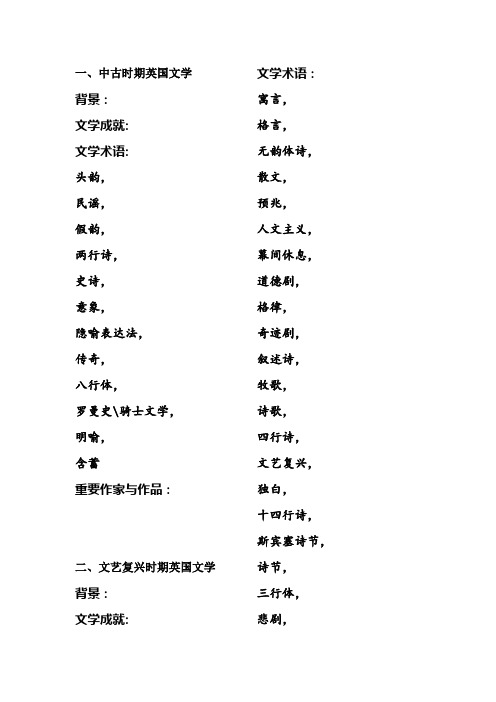
一、中古时期英国文学背景:文学成就:文学术语:头韵,民谣,假韵,两行诗,史诗,意象,隐喻表达法,传奇,八行体,罗曼史\骑士文学,明喻,含蓄重要作家与作品:二、文艺复兴时期英国文学背景:文学成就: 文学术语:寓言,格言,无韵体诗,散文,预兆,人文主义,幕间休息,道德剧,格律,奇迹剧,叙述诗,牧歌,诗歌,四行诗,文艺复兴,独白,十四行诗,斯宾塞诗节,诗节,三行体,悲剧,扬抑格,大学才子重要作家与作品:三、17世纪资产阶级革命和王朝复辟时期背景:文学成就:文学术语:押韵,及时行乐,教诲文学,挽歌,体裁,暗喻,玄学派诗歌,奇想重要作家与作品:四、18世纪英国启蒙运动背景:文学成就:文学术语:旁白,古典主义运动,启蒙运动,结局,书言体小说,闹剧,小说,哥特小说,墓地派诗歌,讽刺史诗,新古典主义,小说(novel),前浪漫主义,叠句,讽刺,意象主义,主题重要作家与作品:五、浪漫主义时期的英国文学背景:文学成就:文学术语:拜伦式英雄,篇、章,寓言,湖湖畔派诗人,抒情诗,颂歌,浪漫主义重要作家与作品:六、维多利亚时期英国批判现实主义文学背景:文学成就:文学术语:暗喻|典故,反面人物,角色,批判现实主义,戏剧独白,倒叙,旁白,陈述者,心理小说,叙述角度,情节,正面人物重要作家与作品:七、20世纪英国文学背景:文学成就:文学术语:唯美主义,黑色幽默,达达主义,顿悟,自由间接引语,现代主义,俄狄甫斯情节,戏谑模仿作品,意识流,超现实主义,荒诞派戏剧,口吻,愤怒的青年重要作家与作品:八、当代英国文学背景:文学成就:文学术语:实验小说,半开放结局,元小说,运动派,极端现实主义戏剧重要作家与作品:一、殖民地时期及独立革命时期的美国文学背景:文学成就:文学术语:美国清教主义,自传重要作家与作品:二、浪漫主义时期的美国文学背景:文学成就:文学术语:美国浪漫主义,美国超验主义,加尔文主义,自由体诗歌,新英格兰诗人,象征,象征主义重要作家与作品:三、现实主义时期的美国文学背景:文学成就:文学术语:美国自然主义,美国现实主义,达尔文主义,地方主义重要作家与作品:四、20世纪美国文学背景:文学成就:文学术语:垮掉的一代,宿命论,表现主义,弗洛伊德学派,哈莱姆文艺复兴,海明威式英雄,印象派,印象主义,爵士乐时代,迷失的一代,新批评派,南方文艺复兴,荒原派作家,约克纳帕塔式重要作家与作品:五、当代美国文学背景:文学成就:文学术语:后现代主义,自白诗,黑山派诗人,重要作家与作品:。
Part1 中古时期的英国文学

Roman(罗马)Conquest
Anglo-Saxon(盎格鲁-撒克逊) Conquest
Norman(诺曼)ቤተ መጻሕፍቲ ባይዱonquest
The Norman Conquest in 1066 marked the beginning of the Medieval English literature, which ended around the end of the 15th century.
Middle English Period
Ⅲ <Piers the Plowman>(耕者皮尔斯)
--William Langland 威廉 兰格伦 Key words: alliterative epic. an allegory(寓言) uses symbolism To relate truth.
Anglo-Saxon Period
Beowulf 贝尔武甫(the national epic of the
English people) feature: alliteration, metaphors and understatements.
诗中的英雄贝奥武甫杀巨魔、 斗毒龙,并在征服这些自然 界恶势力的过程中为民捐躯。 它的背景和情节是北欧的, 但掺有基督教成分,显示出 史诗曾几经修改,已非原貌。 按照保存在一部10世纪的 手抄本里的版本来看,诗的 结构完整,写法生动,所用 的头韵、重读字和代称体现 了古英语诗歌的特色。
坎特伯雷故事集 英国文学史上现实主义第一部杰作
the father of English poetry (wisdom, humor, humanity) 乔叟
英国文学各个时期流派
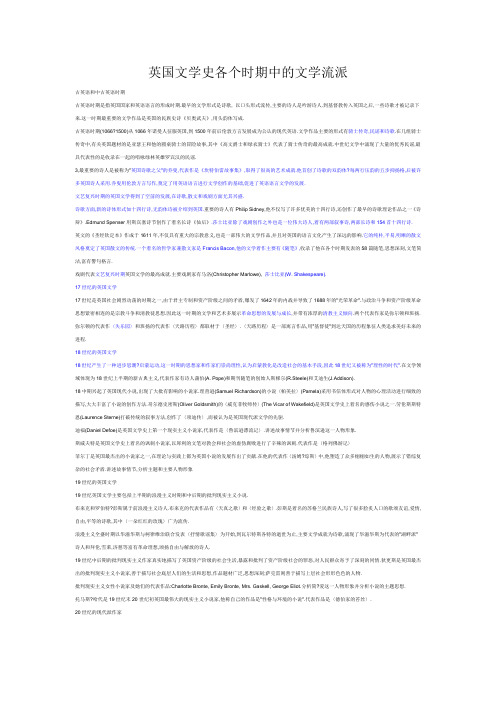
英国文学史各个时期中的文学流派古英语和中古英语时期古英语时期是指英国国家和英语语言的形成时期.最早的文学形式是诗歌, 以口头形式流传,主要的诗人是吟游诗人.到基督教传入英国之后,一些诗歌才被记录下来.这一时期最重要的文学作品是英国的民族史诗《贝奥武夫》,用头韵体写成.古英语时期(1066?1500)从1066年诺曼人征服英国,到1500年前后伦敦方言发展成为公认的现代英语.文学作品主要的形式有骑士传奇,民谣和诗歌.在几组骑士传奇中,有关英国题材的是亚瑟王和他的圆桌骑士的冒险故事,其中《高文爵士和绿衣骑士》代表了骑士传奇的最高成就.中世纪文学中涌现了大量的优秀民谣,最具代表性的是收录在一起的唱咏绿林英雄罗宾汉的民谣.3,最重要的诗人是被称为"英国诗歌之父"的乔叟,代表作是《坎特伯雷故事集》,取得了很高的艺术成就.他首创了诗歌的双韵体?每两行压韵的五步抑扬格,后被许多英国诗人采用.乔叟用伦敦方言写作,奠定了用英语语言进行文学创作的基础,促进了英语语言文学的发展.文艺复兴时期的英国文学得到了空前的发展,在诗歌,散文和戏剧方面尤其兴盛.诗歌方面,新的诗体形式如十四行诗,无韵体诗被介绍到英国.重要的诗人有Philip Sidney,他不仅写了许多优美的十四行诗,还创作了最早的诗歌理论作品之一《诗辩》.Edmund Spenser用斯宾塞诗节创作了着名长诗《仙后》.莎士比亚除了戏剧创作之外也是一位伟大诗人,着有两部叙事诗,两部长诗和154首十四行诗.英文的《圣经钦定本》作成于1611年,不仅具有重大的宗教意义,也是一部伟大的文学作品,并且对英国的语言文化产生了深远的影响.它的纯朴,平易,明晰的散文风格奠定了英国散文的传统.一个着名的哲学家兼散文家是Francis Bacon,他的文学着作主要有《随笔》,收录了他在各个时期发表的58篇随笔,思想深刻,文笔简洁,富有警句格言.戏剧代表文艺复兴时期英国文学的最高成就.主要戏剧家有马洛(Christopher Marlowe), 莎士比亚(W. Shakespeare).17世纪的英国文学17世纪是英国社会剧烈动荡的时期之一,由于君主专制和资产阶级之间的矛盾,爆发了1642年的内战并导致了1688年的"光荣革命".与政治斗争和资产阶级革命思想紧密相连的是宗教斗争和清教徒思想.因此这一时期的文学和艺术多展示革命思想的发展与成长,并带有浓厚的清教主义倾向.两个代表作家是弥尔顿和班扬.弥尔顿的代表作〈失乐园〉和班扬的代表作〈天路历程〉都取材于〈圣经〉.〈天路历程〉是一部寓言作品,用"基督徒"到达天国的历程象征人类追求美好未来的进程.18世纪的英国文学18世纪产生了一种进步思潮?启蒙运动,这一时期的思想家和作家们崇尚理性,认为启蒙教化是改造社会的基本手段,因此18世纪又被称为"理性的时代".在文学领域体现为18世纪上半期的新古典主义,代表作家有诗人蒲伯(A. Pope)和期刊随笔的创始人斯梯尔(R.Steele)和艾迪生(J.Addison).18中期兴起了英国现代小说,出现了大批有影响的小说家.理查逊(Samuel Richardson)的小说〈帕美拉〉(Pamela)采用书信体形式对人物的心理活动进行细致的描写,大大丰富了小说的创作方法.哥尔德史密斯(Oliver Goldsmith)的〈威克菲牧师传〉(The Vicar of Wakefield)是英国文学史上着名的感伤小说之一.劳伦斯斯特恩(Laurence Sterne)打破传统的叙事方法,创作了〈项迪传〉,而被认为是英国现代派文学的先驱.迪福(Daniel Defoe)是英国文学史上第一个现实主义小说家,代表作是〈鲁滨逊漂流记〉.讲述故事情节并分析鲁滨逊这一人物形象.斯威夫特是英国文学史上着名的讽刺小说家,以犀利的文笔对教会和社会的虚伪腐败进行了辛辣的讽刺.代表作是〈格列佛游记〉菲尔丁是英国最杰出的小说家之一,在理论与实践上都为英国小说的发展作出了贡献.在他的代表作〈汤姆?琼斯〉中,他塑造了众多栩栩如生的人物,展示了错综复杂的社会矛盾.讲述故事情节,分析主题和主要人物形象19世纪的英国文学19世纪英国文学主要包括上半期的浪漫主义时期和中后期的批判现实主义小说.布来克和罗伯特?彭斯属于前浪漫主义诗人.布来克的代表作品有〈天真之歌〉和〈经验之歌〉.彭斯是着名的苏格兰民族诗人,写了很多脍炙人口的歌颂友谊,爱情,自由,平等的诗歌,其中〈一朵红红的玫瑰〉广为流传.浪漫主义全盛时期以华滋华斯与柯律维治联合发表〈抒情歌谣集〉为开始,到瓦尔特斯各特的逝世为止,主要文学成就为诗歌,涌现了华滋华斯为代表的"湖畔派"诗人和拜伦,雪莱,济慈等富有革命理想,颂扬自由与解放的诗人.19世纪中后期的批判现实主义作家真实地描写了英国资产阶级的社会生活,暴露和批判了资产阶级社会的罪恶,对人民群众寄予了深刻的同情.狄更斯是英国最杰出的批判现实主义小说家,善于描写社会底层人们的生活和思想,作品题材广泛,思想深刻;萨克雷则善于描写上层社会形形色色的人物.批判现实主义女性小说家及她们的代表作品:Charlotte Bronte, Emily Bronte, Mrs. Gaskell, George Eliot.分析简?爱这一人物形象并分析小说的主题思想.托马斯?哈代是19世纪末20世纪初英国最伟大的现实主义小说家,他称自己的作品是"性格与环境的小说".代表作品是〈德伯家的苔丝〉.20世纪的现代派作家人们对西方文明的危机感和第二次世界大战的恶果促成了西方现代派文学的形成.主要表现为意识流小说,代表作家有詹姆斯乔伊斯和弗洁尼亚沃尔夫.乔伊斯的小说〈尤利西斯〉描写的是现代都市居民庸俗,猥琐的精神生活.弗洁尼亚的〈到灯塔去〉则运用了娴熟的象征手法和意识流技巧.英国文学发展史及每个阶段的特点毋庸置疑,英国小说是世界艺术之林中的一大景观。
Shakespeare之前的英国文学简单介绍
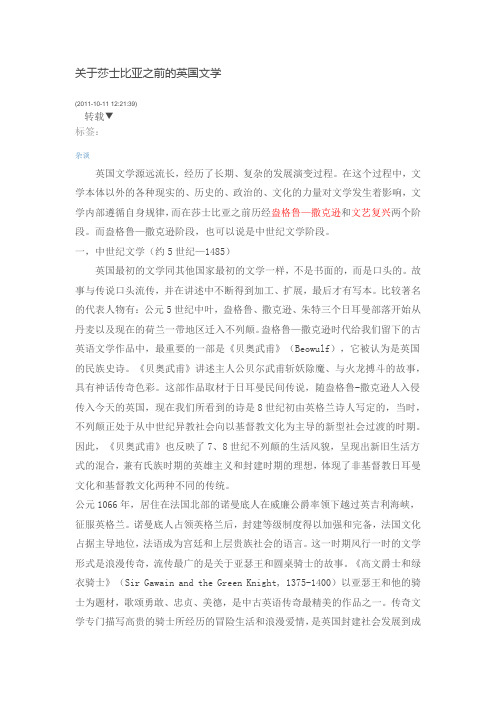
关于莎士比亚之前的英国文学(2011-10-11 12:21:39)转载▼标签:杂谈英国文学源远流长,经历了长期、复杂的发展演变过程。
在这个过程中,文学本体以外的各种现实的、历史的、政治的、文化的力量对文学发生着影响,文学内部遵循自身规律,而在莎士比亚之前历经盎格鲁—撒克逊和文艺复兴两个阶段。
而盎格鲁—撒克逊阶段,也可以说是中世纪文学阶段。
一,中世纪文学(约5世纪—1485)英国最初的文学同其他国家最初的文学一样,不是书面的,而是口头的。
故事与传说口头流传,并在讲述中不断得到加工、扩展,最后才有写本。
比较著名的代表人物有:公元5世纪中叶,盎格鲁、撒克逊、朱特三个日耳曼部落开始从丹麦以及现在的荷兰一带地区迁入不列颠。
盎格鲁—撒克逊时代给我们留下的古英语文学作品中,最重要的一部是《贝奥武甫》(Beowulf),它被认为是英国的民族史诗。
《贝奥武甫》讲述主人公贝尔武甫斩妖除魔、与火龙搏斗的故事,具有神话传奇色彩。
这部作品取材于日耳曼民间传说,随盎格鲁-撒克逊人入侵传入今天的英国,现在我们所看到的诗是8世纪初由英格兰诗人写定的,当时,不列颠正处于从中世纪异教社会向以基督教文化为主导的新型社会过渡的时期。
因此,《贝奥武甫》也反映了7、8世纪不列颠的生活风貌,呈现出新旧生活方式的混合,兼有氏族时期的英雄主义和封建时期的理想,体现了非基督教日耳曼文化和基督教文化两种不同的传统。
公元1066年,居住在法国北部的诺曼底人在威廉公爵率领下越过英吉利海峡,征服英格兰。
诺曼底人占领英格兰后,封建等级制度得以加强和完备,法国文化占据主导地位,法语成为宫廷和上层贵族社会的语言。
这一时期风行一时的文学形式是浪漫传奇,流传最广的是关于亚瑟王和圆桌骑士的故事。
《高文爵士和绿衣骑士》(Sir Gawain and the Green Knight, 1375-1400)以亚瑟王和他的骑士为题材,歌颂勇敢、忠贞、美德,是中古英语传奇最精美的作品之一。
英国文学
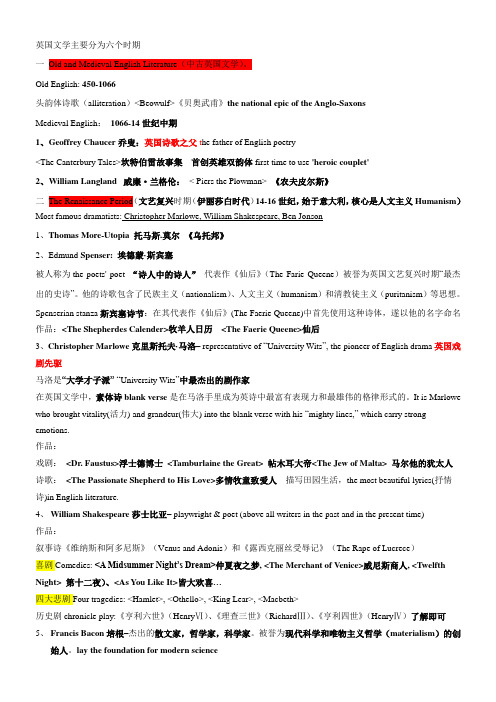
英国文学主要分为六个时期一Old and Medieval English Literature(中古英国文学)。
Old English: 450-1066头韵体诗歌(alliteration)<Beowulf>《贝奥武甫》the national epic of the Anglo-SaxonsMedieval English:1066-14世纪中期1、Geoffrey Chaucer乔叟:英国诗歌之父t he father of English poetry<The Canterbury Tales>坎特伯雷故事集首创英雄双韵体first time to use 'heroic couplet'2、William Langland 威廉·兰格伦:< Piers the Plowman>《农夫皮尔斯》二The Renaissance Period(文艺复兴时期(伊丽莎白时代)14-16世纪,始于意大利,核心是人文主义Humanism)Most famous dramatists: Christopher Marlowe, William Shakespeare, Ben Jonson1、Thomas More-Utopia 托马斯.莫尔《乌托邦》2、Edmund Spenser: 埃德蒙·斯宾塞被人称为the poets' poet “诗人中的诗人”代表作《仙后》(The Farie Queene)被誉为英国文艺复兴时期―最杰出的史诗‖。
他的诗歌包含了民族主义(nationalism)、人文主义(humanism)和清教徒主义(puritanism)等思想。
Spenserian stanza斯宾塞诗节:在其代表作《仙后》(The Faerie Queene)中首先使用这种诗体,遂以他的名字命名作品:<The Shepherdes Calender>牧羊人日历<The Faerie Queene>仙后3、Christopher Marlowe克里斯托夫·马洛– representative of ―University Wits‖, the pioneer of English drama英国戏剧先驱马洛是“大学才子派”―University Wits‖中最杰出的剧作家在英国文学中,素体诗blank verse是在马洛手里成为英诗中最富有表现力和最雄伟的格律形式的。
英国文学 各个时期介绍

and writing an exact man.
? 读书使人充实,讨论使人机智,笔记使人 准确。
? Histories make men wise; poets witty; the mathematics subtle; natural philosophy deep; moral grave; logic and rhetoric able to contend. Abeunt studia in mores.
? 读史使人明智,读诗使人灵秀,数学使人 周密,科学使人深刻,伦理学使人庄重, 逻辑修辞之学使人善辩:凡有所学,皆成 性格。
威廉?莎士比亚
? William Shakespeare ? 1564~1616 ? 英国戏剧之父 ? 两首长诗,154首十四行诗和38部(或39
部)戏剧
莎士比亚 历史剧
? 概括了英国历史上百余年间的动乱,塑造 了一系列正、反面君主形象,反映了莎士 比亚反对封建割据,拥护中央集权,谴责 暴君暴政,要求开明君主进行自上而下改 革,建立和谐社会关系的人文主义政治与 道德理想。
莎士比亚 喜剧
? 大多以爱情、友谊、婚姻为主题,主人公 多为具有人文主义智慧与美德的青年男女 ,通过他们争取自由、幸福的斗争,歌颂 进步、美好的新人新风,同时也温和地揭 露和嘲讽旧事物的衰腐和丑恶。这一时期 的戏剧创作的基本情调是乐观、明朗的, 充满着以人文主义理想解决社会矛盾的信 心
Excalibur
杰弗利·乔叟Geoffrey Chaucer
? 约1343~1400 ? “英国诗歌之父” ? 乔叟的诗歌创作分为三个时期 ? ①法国影响时期 ? ②意大利影响时期 ? ③成熟时期 ? 《坎特伯雷故事》The Canterbury Tales ? 英国文学史上现实主义的第一部典范。
英国文学
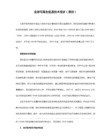
《论戏剧诗》
4、 亚历山大.蒲柏:英国新古典主义诗歌的重要代表;英雄双韵体的使用达到登峰造极的使用;《田园组诗》是其最早田园诗歌代表作
5、 托马斯、格雷:感伤主义中墓园诗派的代表人物 《墓园挽歌》
6、 威廉、布莱克:天真之歌、经验之歌;
乐观时期:《波兹特写》《匹克维克外传》《雾都孤儿》《老古玩店》;
不乐观时期:《美国札记》《董贝父子》《大卫科波菲尔》
后期:《荒凉山庄》《艰难时事》《双城记》《远大前程》
17、萨克雷:《名利场》《亨利 埃斯蒙德》《纽克母一家》
18、托马斯、哈代:
《远离尘嚣》《还乡》《喀斯特桥市长》《威塞克斯故事集》
2、叶芝:爱尔兰使人 《芦苇的风》《库尔的野天鹅》《驶向拜占庭》
3、John Galsworthy:《福尔赛世家》三部曲the man of property; in chancery; to let;
4、Herbert George wells:现代科幻小说:modern science fiction的鼻祖;《时间机器》
19、飞利浦、拉金:运动派诗人的领袖;
五、 维多利亚时期的英国文学(19世纪)
1、 威廉、华兹华斯:桂冠诗人;《独自云游》《孤独的割麦女》
《抒情歌谣集》最杰出的诗篇;
《序曲》;
2、 柯勒律治:《古舟子咏》《忽必烈汗》《克里斯贝尔》
3、 骚赛:桂冠诗人;《Thalaba the destroyer》是骚赛最重要的长篇史诗之一;另一各是《格拉玛的诅咒》
10、弗吉尼亚、伍尔夫:《雅各布的房间》《到灯塔去》《浪》;
11、E.M.Forster: 《通往印度之路》
专八人文知识之英国文学
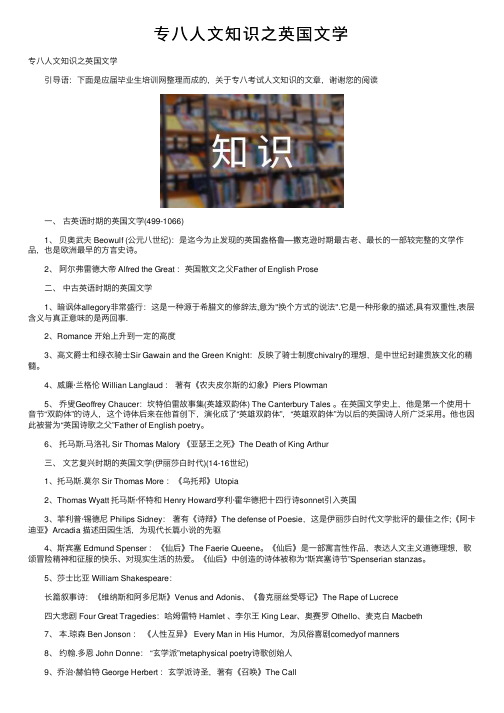
专⼋⼈⽂知识之英国⽂学专⼋⼈⽂知识之英国⽂学 引导语:下⾯是应届毕业⽣培训⽹整理⽽成的,关于专⼋考试⼈⽂知识的⽂章,谢谢您的阅读 ⼀、古英语时期的英国⽂学(499-1066) 1、贝奥武夫 Beowulf (公元⼋世纪):是迄今为⽌发现的英国盎格鲁—撒克逊时期最古⽼、最长的⼀部较完整的⽂学作品,也是欧洲最早的⽅⾔史诗。
2、阿尔弗雷德⼤帝 Alfred the Great :英国散⽂之⽗Father of English Prose ⼆、中古英语时期的英国⽂学 1、暗讽体allegory⾮常盛⾏:这是⼀种源于希腊⽂的修辞法,意为"换个⽅式的说法".它是⼀种形象的描述,具有双重性,表层含义与真正意味的是两回事. 2、Romance 开始上升到⼀定的⾼度 3、⾼⽂爵⼠和绿⾐骑⼠Sir Gawain and the Green Knight:反映了骑⼠制度chivalry的理想,是中世纪封建贵族⽂化的精髓。
4、威廉·兰格伦 Willian Langlaud :著有《农夫⽪尔斯的幻象》Piers Plowman 5、乔叟Geoffrey Chaucer:坎特伯雷故事集(英雄双韵体) The Canterbury Tales 。
在英国⽂学史上,他是第⼀个使⽤⼗⾳节“双韵体”的诗⼈,这个诗体后来在他⾸创下,演化成了“英雄双韵体”,“英雄双韵体”为以后的英国诗⼈所⼴泛采⽤。
他也因此被誉为“英国诗歌之⽗”Father of English poetry。
6、托马斯.马洛礼 Sir Thomas Malory 《亚瑟王之死》The Death of King Arthur 三、⽂艺复兴时期的英国⽂学(伊丽莎⽩时代)(14-16世纪) 1、托马斯.莫尔 Sir Thomas More :《乌托邦》Utopia 2、Thomas Wyatt 托马斯·怀特和 Henry Howard亨利·霍华德把⼗四⾏诗sonnet引⼊英国 3、菲利普·锡德尼 Philips Sidney:著有《诗辩》The defense of Poesie,这是伊丽莎⽩时代⽂学批评的最佳之作;《阿卡迪亚》Arcadia 描述⽥园⽣活,为现代长篇⼩说的先驱 4、斯宾塞 Edmund Spenser :《仙后》The Faerie Queene。
中古英语文学
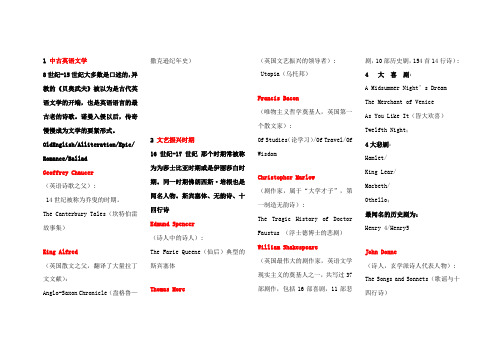
1 中古英语文学8世纪-15世纪大多数是口述的,异教的《贝奥武夫》被以为是古代英语文学的开端,也是英语语言的最古老的诗歌。
诺曼入侵以后,传奇慢慢成为文学的要紧形式。
OldEnglish/Alliteration/Epic/ Romance/BalladGeoffrey Chaucer(英语诗歌之父):14世纪被称为乔叟的时期。
The Canterbury Tales(坎特伯雷故事集)King Alfred(英国散文之父,翻译了大量拉丁文文献):Anglo-Saxon Chronicle(盎格鲁—撒克逊纪年史)2 文艺振兴时期16世纪-17世纪那个时期常被称为为莎士比亚时期或是伊丽莎白时期。
同一时期佛朗西斯·培根也是闻名人物。
斯宾塞体、无韵诗、十四行诗Edmund Spencer(诗人中的诗人):The Farie Queene(仙后)典型的斯宾塞体Thomas More(英国文艺振兴的领导者):Utopia(乌托邦)Francis Bacon(唯物主义哲学奠基人,英国第一个散文家):Of Studies(论学习)/Of Travel/OfWisdomChristopher Marlow(剧作家,属于“大学才子”,第一制造无韵诗):The Tragic History of DoctorFaustus (浮士德博士的悲剧)William Shakespeare(英国最伟大的剧作家,英语文学现实主义的奠基人之一,共写过37部剧作,包括16部喜剧,11部悲剧,10部历史剧,154首14行诗):4 大喜剧:A Midsummer Night’s DreamThe Merchant of VeniceAs You Like It(皆大欢喜)Twelfth Night;4大悲剧:Hamlet/King Lear/Macbeth/Othello;最闻名的历史剧为:Henry 4/Henry5John Donne(诗人,玄学派诗人代表人物):The Songs and Sonnets(歌谣与十四行诗)A Valediction: Forbidding Mourning(别离辞·节哀)John Milton(革命时期最伟大诗人):Paradise Lost/Paradise Regained/悲剧:Samson Agonistes(力士参孙)3 新古典时期17世纪中期-18世纪本时期是受到启蒙运动的阻碍,要紧为现实主义的特点,散文体为主prose,报纸和杂志开始显现。
英国文学风尚的历史演变及其对现代英国文化的影响

英国文学风尚的历史演变及其对现代英国文化的影响英国文学是无疑是世界文学的一极。
从莎士比亚、狄更斯、奥斯汀、布朗特到现代的J·K·罗琳和伊恩·麦克尤恩等,英国文学凭借其深刻、丰富、精湛等特点,在世界范围内享有盛誉。
本文旨在探究英国文学风尚的历史演变及其对现代英国文化的影响。
一、中古时期英国文学的历史可以追溯到中古时期。
在这个时期,英国文学主要表现为民族史诗、英雄传说等,最为著名的有《贝奥武夫》、《世界之树》、《西班牙的El Cid》等。
中古时期的英国文学主要受到盎格鲁-撒克逊文化和基督教文化的影响。
其中盎格鲁-撒克逊文化主要表现为英雄传说和战争、荒野、宗教等题材,而基督教文化主要表现为圣经故事等宗教题材。
这些文学作品正如英国的历史一样具有多样性和震撼力,同时也在人民中不断发扬着文学的精髓,促进了英国文学的发展,并对现代英国文学产生了深远的影响。
二、文艺复兴时期文艺复兴时期是英国文学史上的重要分水岭之一。
这个时期,英国文学的风格和内容发生了重大变化。
莎士比亚被誉为这个时期最伟大的作品家之一,他的作品在英国文学发展史上具有划时代的意义。
文艺复兴时期的英国文学突破了宗教的约束,主张讲述个人的生活、爱情和人性等观念,展现了作者心灵的感悟。
此时期代表性的作品有莎士比亚的《哈姆雷特》、《罗密欧与朱丽叶》、《李尔王》等。
三、近代时期近代时期的英国文学,主要表现为现实主义、自然主义和现代主义等文学流派。
其中,狄更斯、勃朗特姐妹等作家的现实主义作品,体现了当时社会的底层生活,其作品普及的社会价值深远;而由作家乔伊斯引领的现代主义,则更多地表达了当时人们对生命、人性、意识等方面的思考。
这些作品为英国积累了可贵的文学经验和清晰的文化形象,造就了英国文学现代化和现代文化的兴盛。
四、现代社会的英国文学从宏观的视角看,当今的英国文化是在传统文化基础上逐渐演变而成的。
在当代英国的文学创作中,从小说、散文、戏剧到诗歌,都能收获人们对当代社会和现实生活的深刻精神体验。
英国文学知识简单整理
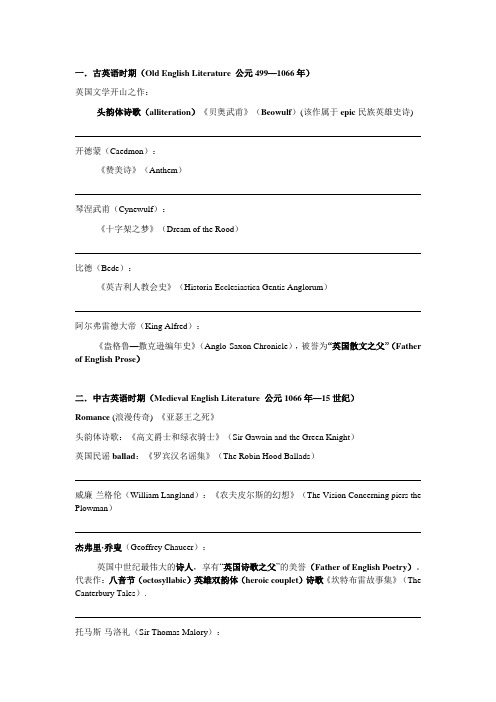
一.古英语时期(Old English Literature 公元499—1066年)英国文学开山之作:头韵体诗歌(alliteration)《贝奥武甫》(Beowulf)(该作属于epic民族英雄史诗)开德蒙(Caedmon):《赞美诗》(Anthem)琴涅武甫(Cynewulf):《十字架之梦》(Dream of the Rood)比德(Bede):《英吉利人教会史》(Historia Ecclesiastica Gentis Anglorum)阿尔弗雷德大帝(King Alfred):《盎格鲁—撒克逊编年史》(Anglo-Saxon Chronicle),被誉为“英国散文之父”(Father of English Prose)二.中古英语时期(Medieval English Literature 公元1066年—15世纪)Romance (浪漫传奇) 《亚瑟王之死》头韵体诗歌:《高文爵士和绿衣骑士》(Sir Gawain and the Green Knight)英国民谣ballad:《罗宾汉名谣集》(The Robin Hood Ballads)威廉·兰格伦(William Langland):《农夫皮尔斯的幻想》(The Vision Concerning piers the Plowman)杰弗里·乔叟(Geoffrey Chaucer):英国中世纪最伟大的诗人,享有“英国诗歌之父”的美誉(Father of English Poetry)。
代表作:八音节(octosyllabic)英雄双韵体(heroic couplet)诗歌《坎特布雷故事集》(The Canterbury Tales).托马斯·马洛礼(Sir Thomas Malory):英国15世纪优秀的散文家,代表作为《亚瑟王之死》(Le Morte d’Arthur)三.文艺复兴时期(Renaissance 15世纪末—17世纪)托马斯·莫尔(Thomas More):伟大的人文主义者,代表作:《乌托邦》(Utopia),《国王爱德华五世悲戚的一生》(The painful Life of Edward Ⅴ).托马斯·魏厄特(Thomas Wyatt)和亨利·霍华德(Henry Howard)的十四行诗(Sonnet).前者将意大利十四行诗引入英国;后者在此基础上,发展了英国十四行诗歌。
英国文学
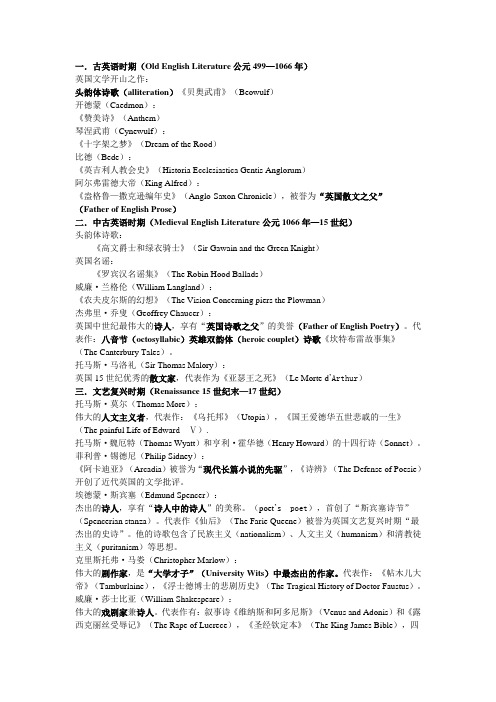
一.古英语时期(Old English Literature 公元499—1066年)英国文学开山之作:头韵体诗歌(alliteration)《贝奥武甫》(Beowulf)开德蒙(Caedmon):《赞美诗》(Anthem)琴涅武甫(Cynewulf):《十字架之梦》(Dream of the Rood)比德(Bede):《英吉利人教会史》(Historia Ecclesiastica Gentis Anglorum)阿尔弗雷德大帝(King Alfred):《盎格鲁—撒克逊编年史》(Anglo-Saxon Chronicle),被誉为“英国散文之父”(Father of English Prose)二.中古英语时期(Medieval English Literature 公元1066年—15世纪)头韵体诗歌:《高文爵士和绿衣骑士》(Sir Gawain and the Green Knight)英国名谣:《罗宾汉名谣集》(The Robin Hood Ballads)威廉·兰格伦(William Langland):《农夫皮尔斯的幻想》(The Vision Concerning piers the Plowman)杰弗里·乔叟(Geoffrey Chaucer):英国中世纪最伟大的诗人,享有“英国诗歌之父”的美誉(Father of English Poetry)。
代表作:八音节(octosyllabic)英雄双韵体(heroic couplet)诗歌《坎特布雷故事集》(The Canterbury Tales)。
托马斯·马洛礼(Sir Thomas Malory):英国15世纪优秀的散文家,代表作为《亚瑟王之死》(Le Morte d’Arthur)三.文艺复兴时期(Renaissance 15世纪末—17世纪)托马斯·莫尔(Thomas More):伟大的人文主义者,代表作:《乌托邦》(Utopia),《国王爱德华五世悲戚的一生》(The painful Life of Edwar d Ⅴ).托马斯·魏厄特(Thomas Wyatt)和亨利·霍华德(Henry Howard)的十四行诗(Sonnet)。
British Literature英国文学名词解释,整理背诵
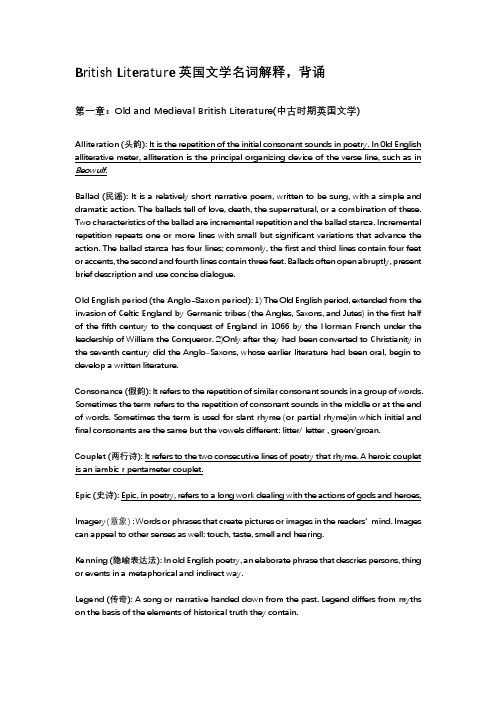
British Literature英国文学名词解释,背诵第一章:Old and Medieval British Literature(中古时期英国文学)Alliteration (头韵): It is the repetition of the initial consonant sounds in poetry. In 0ld English alliterative meter, alliteration is the principal organizing device of the verse line, such as in Beowulf.Ваllаd (民谣): It is a relatively short narrative poem, written to be sung, with a simple and dramatic action. The ballads tell of love, death, the supernatural, or a combination of these. Two characteristics of the ballad are incremental repetition and the ballad stanza. Incremental repetition repeats one or more lines with small but significant variations that advance the action. The ballad stanza has four lines; commonly, the first and third lines contain four feet or accents, the second and fourth lines contain three feet. Ballads often open abruptly, present brief description and use concise dialogue.Old English period (the Anglo-Saxon period): 1) The Old English period, extended from the invasion of Celtic England by Germanic tribes (the Angles, Saxons, and Jutes) in the first half of the fifth century to the conquest of England in 1066 by the Norman French under the leadership of William the Conqueror. 2)Only after they had been converted to Christianity in the seventh century did the Anglo-Saxons, whose earlier literature had been oral, begin to develop a written literature.Consonance (假韵): It refers to the repetition of similar consonant sounds in a group of words. Sometimes the term refers to the repetition of consonant sounds in the middle or at the end of words. Sometimes the term is used for slant rhyme (or partial rhyme)in which initial and final consonants are the same but the vowels different: litter/ letter , green/groan.Couplet (两行诗): It refers to the two consecutive lines of poetry that rhyme. A heroic couplet is an iambic r pentameter couplet.Epic (史诗): Epic, in poetry, refers to a long work dealing with the actions of gods and heroes,Imagery (意象) : Words or phrases that create pictures or images in the readers‘mind. Images can appeal to other senses as well: touch, taste, smell and hearing.Kenning (隐喻表达法): In old English poetry, an elaborate phrase that descries persons, thing or events in a metaphorical and indirect way.Legend (传奇): A song or narrative handed down from the past. Legend differs from myths on the basis of the elements of historical truth they contain.Ottava Rima ( 八行体): A form of eight-line stanza, the rhyme scheme is abababcc.Romance (罗曼史/骑士文学): Any imagination literature that is set in an idealized world and deals with heroic adventures and battles between good characters and villains or monsters. Originally, the term referred to a medieval tale dealing with the loves and adventures of kings, queens, knights and ladies, and including unlikely or supernatural happenings. Sir Gawain and the Green Knight (高文爵士与绿衣骑士) is the best of medieval romances. John Keats‘The Eve of St. Agnes (圣爱格尼斯节前夕) is one of the greatest metrical romances ever written.Simile (明喻): A comparison made between two things through the use of a specific word of comparison, such as like, as, than or resemble, and the comparison must be between two essentially unlike things.Understatement (含蓄): It is a figure of speech in literature writing. It deliberately represents something as very much less in magnitude or importance than it really is, or is ordinarily considered to be. The effect usually is ironic.Middle English period: The four and a half centuries between the Norman Conquest in 1066, which effected radical changes in the language, life, and culture of England, and about 1500, when the standard literary language had become recognizably modern English, that is, similar to the language we speak and write today.Arthurian legend: It is a group of tales (in several languages) that developed in the Middle Ages concerning Arthur, semi-historical king of the Britons and his knights. The legend is a complex weaving of ancient Celtic mythology with later traditions around a core of possible historical authenticity.第二章:British Literature of the Renaissance Period (文艺复兴时期英国文学)Allegory (寓言): A tale in verse or prose in which characters, actions, or settings represent abstract ideas or moral qualities. An allegory is a story with two meanings: a literal meaning and a symbolic meaning.Aphorism (格言): A concise, pointed statement expressing a wise or clever observation about life.Blank verse (无韵体诗): Verse written in unrhymed iambic pentameter. It is the verse form used in some of the greatest English poetries, including that of William Shakespeare and John Milton.Comedy (喜剧): In general, a literary work that ends happily with a healthy ,amicable armistice between the protagonist and society.Essay (散文): A piece of prose writing, usually short, that deals with a subject in a limited way and expresses a particular point of view. An essay may be serious or humorous, tightly organized or rambling, restrained or emotional. The two general classifications of essay are: the informal essay and the formal essay. An informal essay is usually brief and is written as if the writer is talking informally to the readers about some topic, using a conversational style and a personal or humorous tune. By contrast, a formal essay is tightly organized, dignified in style and serious in tone.Foreshadowing (预兆): The use of hints or clues in a narrative lo suggest what will happen later. Writers use foreshadowing to create interest and to build suspense. Sometimes foreshadowing also prepares the reader for the ending of the story.Humanism ( 人文主义): Humanism is the essence of the Renaissance. It emphasizes the dignity of human beings and the importance of the present life. Humanists voiced their beliefs that man was the center of the universe and man did not only have the right to enjoy the beauty of the present life , but had the ability to perfect himself and to perform wonders.Paradox(似非而是): A statement or expression so surprisingly self-contradictory as to provoke us into seeking another sense or context in which it would be true.Morality Play (道德剧) : An outgrowth of Miracle Plays. Morality Play was popular in the 15th and 16th centuries. In it, virtues and vices were personified.Meter (格律) : A generally regular pattern of stressed and unstressed syllables in poetry. The analysis of the meter is called scansion.Miracle Play (奇迹剧) : A popular religious drama of medieval England. Miracle Plays were based on stories of the saints or sacred history.Narrative poem (叙述诗): A Narrative poem refers w a poem that tells a story. It may consist of a series of incidents, as in Homer's The Iliad and The Odysseus, and John Milton's Paradise Lost.Pastoral (牧歌): A type of poem that deals in an idealized way with shepherds and rustic life. Two pastoral poems are Christopher Marlow's The Passionate Shepherd to His Lover and Sir Walter Raleigh's The Nymph’s Reply to the Shepherd.Ralegh’s poem might be called anti-pastoral because of its realistic tone.Poetry (诗歌): The most distinctive characteristics of poetry are form and music. Poetry is concerned with not only what is said but how it is said. Poetry evokes emotions rather than express facts. Poetry means having a poetic experience. Imagination is also an essential quality of poetry. Poetry often leads us to new perceptions, new feelings and experiences of which we have not previously been aware.Quatrain (四行诗): Usually a stanza or poem of four lines. A quatrain can also be any group of four lines unified by a rhyme scheme. Quatrains usually follow an abab, abba or abcb rhyme scheme.Renaissance (文艺复兴): The term originally indicated a revival of classical (Greek and Roman) arts and sciences after the dark ages of medieval obscurantism. Humanism is the essence of Renaissance. The real mainstream of English Renaissance is the Elizabethan drama with William Shakespeare being the leading dramatist.Soliloquy (独白): In drama, an extended speech delivered by a character alone on stage. The character reveals his or her innermost thoughts and feelings directly to the audience, as if thinking aloud.Sonnet (十四行诗): A fourteen-line lyric poem, usually written in rhymed iambic pentameter.A sonnet generally expresses a single theme or idea.Spenserian Stanza (斯宾塞诗节):A nine-line stanza with the flowing rhyme scheme: ababbcbcc. The first eight lines are written in iambic pentameter. The ninth line is written in iambic hexameter and is called an alexandrine.Stanza (诗节):It’s a structural divi sion of a poem, consisting of a series of verse line which usually comprise a recurring pattern of meter and rhyme.Terza rima (三行体): An Italian verse form consisting of a series of thee-line stanzas in which the middle line of each stanza rhymes with the first and third lines of the following stanza.Tragedy (悲剧): In general, a literary work in which the protagonist meets an unhappy or disastrous end. Unlike comedy, tragedy depicts the actions of a central character who is usually dignified or heroic.Trochee (抑扬格):A metrical foot used in formal poetry. It consists of a stressed syllable followed by an unstressed one.University Wits (大学才子):University Wits refers to a group of scholars during the Elizabethan Age who graduated from cither Oxford or Cambridge. They came to London with the ambition to become professional writers. Some of them later became famous poets and playwrights. They were called" University Wis". Robert Greene, Thomas Kyd, Jhon Lyly and Christopher Marlowe were among them. They paved the way, to some extent, for the coming of Shakespeare.Utopia (乌托邦): It is written in a conversation form between More and Hythloday, a returned voyager. It is divided into two books. The first book contains a long discussion on the social conditions of England. The second book describes in detail an ideal communist society, Utopia.Francis Bacon: Francis Bacon (1561-1626), was an English philosopher, statesman, scientist, lawyer, jurist, author and pioneer of the scientific method. He served both as Attorney General and Lord Chancellor of England. Although his political career ended in disgrace, he remained extremely influential through his works, especially as philosophical advocate and practitioner of the scientific method during the scientific revolution. His essays are famous for its brief and wise quotations and the most widely-read works are his essays “Of Studies”, “Of Truth” and “Of Death”.第三章:The 17th Century -The Period of Revolution and Restoration (17世纪资产阶级革命和王朝复辟时期)Assonance (押韵): The repetition of similar vowel sounds, especially in poetry. Assonance is often employed to please the ear or emphasize certain sounds.Carpe Diem (及时行乐):A tradition dating back to classical Greek and Latin poetry and particularly popular among English Cavalier poets. Carpe Diem means literally “seize the day”, that is, “live for today”.Didactic literature (教诲文学):Didactic literature is said to be didactic if it deliberately teaches some moral lessons. The use of literature for such teaching is one of its traditional justifications.Elegy (挽歌): A poem of mourning, usually over the death of an individual. An elegy is a type of lyric poem, usually formal in language and structure, and solemn or even melancholy in tone.Genre (体裁):A literary species or form, e. g·, tragedy, epic, comedy, novel, essay, biography and lyric poem.Metaphor (暗喻): A figure of speech that makes a comparison between two things that are basically dissimilar. Unlike simile, a metaphor does not use a connective word such as like, as, or resemble in making the comparison.Metaphysical poetry (玄学派诗歌) : The poetry of John Donne and other 17th century poets who wrote in a similar style. Metaphysical poetry is characterized by verbal wit and excess, ingenious structure, irregular meter, colloquial language, elaborate imagery, and a drawing-together of dissimilar ideas.Conceit (奇想): Conceit is a far-fetched simile or metaphor; a literary conceit occurs when the speaker compares two highly dissimilar things. Conceit is extensively employed in John Donne's poetry.Paradise Lost: Paradise Lost is an epic poem in blank verse by the 17th-century English poetJohn Milton:The poem concerns the Christian story of “the Fall of Man”: the temptation of Adam and Eve by the fallen angel Satan and their expulsion from the Garden of Eden. Milton's purpose, stated in Book I, is to " justify the ways of God to men and elucidate the conflict between God's eternal foresight and free will.blank verse: Blank verse is a type of poetry, distinguished by having a regular meter, but no rhyme. In English, the meter most commonly used with blank verse has been iambic pentameter (as used in Shakespearean plays). The first known use of blank verse in the English language was by Henry Howard, Earl of Surrey. Christopher Marlowe was the first English author to make full use of the potential of blank verse, and also established it as the dominant verse form for English drama in the age of Elizabeth I and James I. The major achievements in English blank verse were made by William Shakespeare, who wrote much of the content of his plays in unrhymed iambic pentameter, and Milton, whose Paradise Lost was written in blank verse.第四章: The 18th Century- -The Age of Enlightenment in England (18世纪英国启蒙运动阶段)Aside (旁白): In drama, line spoken by a character in an undertone or directly to the audience. An aside is meant to be heard by the other characters onstage.Classicism (古典主义运动): A movement or tendency in art, literature, or music that reflects the principles manifested in the art of ancient Greece and Rome. Classicism emphasizes the traditional and the universal, and the places value on reason, clarity, balance, and order. Classicism, with its once for reason and universal themes, is traditionally opposed to Romanticism, which is concerned with emotions and personal themes.Enlightenment Movement (启蒙运动):Enlightenment is an intellectual movement that originates in Europe and comes to America in the 18th century. It stresses the power of human reason, the importance of methods and discoveries instead of God. Its purpose is to enlighten the whole world with the light of modern philosophical and artistic ideas. It celebrates reason or rationality, equality and science. It advocates universal education.Denouement (结局): The outcome of a plot. The denouement is that part of a play, short story, novel, or narrative poem in which conflicts are resolved or unraveled, and mysteries and secrets connected with the plot are explained.Epistolary novel (书信体小说): An epistolary novel is a novel told through the medium of letters written by one or more of the characters. The usual form is the letter, but diary entries, newspaper clipping and other documents are sometimes used. The epistolary novel's reliance on subjective points of view makes it the forerunner of the modern psychological novel.Farce (闹剧):A type of comedy based on a ridiculous situation, often with stereotyped characters. The humor in a farce is largely slapstick--that is, it often involves crude physical action. The characters in a farce are often the butts of practical jokes.Fiction (小说) : Prose narrative based on imagination, usually a novel or a short story.Gothic Romance (哥特小说): A type of novel that flourished in the lat-18th and early-19th century in England. Gothic romances are mysteries, often involving the supernatural and heavily tinged with horror, and they are usually against dark backgrounds of medieval ruins and haunted castles.The Graveyard School (墓地派诗歌): The Graveyard School refers to a school of poets of the 18th century whose poems are mostly devoted to a sentimental lamentations or meditation on life, past and present, with death and graveyard as themes. Thomas Gray is considered to be the leading figure of this school and his Elegy Witten in a Country Churchyard is his most representative work.Mock epic (讽刺史诗): A comic literary form that treats a trivial subject in the grand, heroic style of the epic. A mock epic is also referred to as a mock heroic poem.Neoclassicism (新古典主义): A revival in the 17th and 18th centuries of classical standards of order, balance, and harmony in literature. John Dryden and Alexander Pope were major exponents of the neoclassical school.Novel (小说): A book-length fictional prose narrative, having many characters and often a complex plot.Pre-romanticism (前浪漫主义): It originated among the conservative groups of men and letters as a reaction against Enlightenment and found its most manifest expression in the "Gothic Novel”. The term arose from t he fact that the greater part of such romances were devoted to the medieval times.Refrain (叠句): A word phrase, line or group of lines repeated regularly in a poem, usually at the end of each stanza. Refrains are often used in ballads and narrative poems to create a songlike rhythm and to help build suspense. Refrains can also serve to emphasize a particular idea.Satire (讽刺): A kind of writing that holds up to ridicule or contempt the weaknesses and wrong doings of individuals, groups, intuitions, or humanity in general. The aim of satirists is to set a moral standard for society, and they attempt to persuade the readers to see their points of view through the force of laughter.Sentimentalism (感伤主义): Sentimentalism came into being as a result of a bitter discontent on the part of certain enlighteners in social reality. It is a pejorative term to describe false orsuperficial emotion, assumed feeling, self-regarding postures of grief and pain. In literature, it denotes " pathetic indulgence”.Theme (主题): The general idea or insight about life that a writer wishes to express in a literary work. All the elements of a literary work- plot, setting, characterization, and figurative language---contribute to the development of its theme.English Enlightenment: With the advent of the 18th century in England, there sprang into life a progressive intellectual movement known as the Enlightenment or the Age of Reason. The enlighteners held the common faith in human rationality, eternal justice and natural equality. The great enlighteners in Britain were those great writers like Alexander Pope, Joseph Addison, Jonathan Swift and Samuel Johnson.British neoclassicism: In English literature, the stylistic trend between the Restoration and the advent of romanticism at the beginning of the 19th century is referred to as neoclassicism. The term " neoclassicism” is derived from the convictions of the leading poet-critics of the age that literary theory and practice should follow the models established by Greek and Latin writers. These critics held that writers should emphasize types rather than individual characteristics; adhere to " nature " by aspiring to order and regularity; and strictly observe the unities of time, place, and action in dramatic composition. Major British neoclassicists are John Dryden, Alexander Pope and Samuel Johnson."A Modest Proposal":"A Modest Proposal" is a famous satire written by Jonathan Swift. Assuming the cool tone of an impartial outsider, the author suggests that children of the poor Irish people be sold at one year old as food for the English nobles, Written with much conciseness and terseness, the " proposal" is by far the most consummate artistic expression of Swift’s indignation toward the terrible oppression and exploitation of the Irish people by the English ruling class.Picaresque novel: 1) Derived from the Spanish word picara, meaning " rogue" or " rascal”, the term generally refers to a basically realistic and often satiric work of fiction chronicling the career of an engaging, lower-class rogue-hero, who takes to the road for a series of loose, episodic adventures, sometimes in the company of a sidekick. 2) Well-known examples of the picaresque novel are Cervantes Don Quixote (1605) and Henry Fielding's Tom Jones (1749).第五章The Age of Romanticism (浪漫主义时期的英国文学)Byronic hero (拜伦式的英雄) :Byronic hero refers to a proud, mysterious rebel figure of noble origin. With immense superiority in his passions and powers, he would carry on his shoulders the burden of righting all the wrongs in a corrupt society, and would rise single-handedly against any kind of tyrannical rules either in government, in religion, or in moral principles with unconquerable wills and inexhaustible energies.Canto (篇/章): A section or division of a long poem. In English poetry , Alexander Pope's The Rape of the Lock (《夺发记》)and Byron's Don Juan (《唐璜》) are divided into cantos.Fable (寓言): A fable is a short story, often with animals as its characters. It illustrates a moral.Lake Poets (湖畔派诗人); Romantic poets such poets as Willian Wordsworth, Samuel Taylor Coleridge and Robert Southey who lived in the Lake District came to be known as the Lake School or Lake poets.Lyric (抒情诗): Lyric is a poem, usually a short one, which expresses a speaker’s personal thought and feelings. The elegy, ode, and Bonnet are all forms of the lyric.Ode (颂歌) : Usually a lyric poem of moderate length, with a serious subject, an elevated style, and an elaborate stanza pattern. The ode often praises people, the arts of music and poetry, natural scenes, or abstract concepts, The Romantic poets used the ode to explore either personal or general problems; they often started with a meditation on something in nature ,as Keats' Ode to a Nightingale or Shelley's Ode to the West Wind.Romanticism (浪漫主义): A movement that flourished in literature, philosophy, music, and art in Western culture during most of the 19th century, beginning as a revolt against classicism. Romanticism gave primary concern to passion, emotion, and natural beauty. The English Romantic period is an age of poetry.tercet: Tercet refers to a unit of three verse lines, usually rhyming either with each other or with neighboring lines and three-line stanzas of terza rima and of the villanelle are known as tercets.Charles Lamb: Charles Lamb (1775- -1834) was an English essayist, best known for his Essays of Elia and children's book Tales from Shakespeare, which he produced with his sister, Mary Lamb. Lamb has been referred to as the most lovable figure in English literature, and his influence on the English essay form surely cannot be overestimated.第六章The Victorian Period- English Critical Realism (维多利亚时期英国批判现实主义文学)Allusion (暗指/典故): A reference to a person, a pace, an event or a literary work that a writer expects the readers to recognize and respond to. An allusion may be drawn from history, geography, literature or religion.Antagonist (反面人物): A person or force opposing the protagonist in a narrative; a rival of the hero or heroine.Character (角色):In appreciating a short story, characters are indispensable elements. Characters are the persons presented in a dramatic or narrative work. Forst divides characters into two types: flat character, which is presented without much individualizing detail; and round character, which is complex in temperament and motivation and is represented with subtle particularity.Critical Realism (批判现实主义): The Critical Realism of the I9h century flourished in the 1840s and in the beginning of the 1850s. The realists first and foremost set themselves the task of criticizing capitalist society from a democratic viewpoint and delineated the crying contradictions of bourgeois reality. But they did not find way to eradicate social evils. Charles Dickens is the most important critical realist.Dramatic Monologue (戏剧独白): A kind of narrative poem in which one character speaks to one or more listeners whose replies are not given in the poem. The occasion is usually a crucial one in the speaker's personality as well as the incident that is the subject of the poem. Robert Browning's My Last Duchess is a typical example.Flashback (倒叙): A scene in a short story, novel, play or narrative poem that interrupts the action to show an event that happened earlier.Narration (叙述) : Like description, narration is a part of conversation and writing. Narration is the major technique used in expository writing, such as autobiography Successful narration must grow out of good observation, to-the-point selection from observation and clear arrangement of details in logical sequence, which is usually chronological. Narration gives an exact picture of things as they occur.Narrator (陈述者) : One who narrates or tells a story. A story may be told by a first-person narrator, someone who is either a major or minor character in the story. Or a story may be told by a third-person narrator, someone who is not in the story at all. Narrator can also refer to a character in a drama who guides the audience through the play, often commenting on the action and sometimes participating in it.Psychological Novel (心里小说):It refers to a kind of novels that dwell on a complex psychological development and present much of the narration through the inner workings of a character's mind. Thackeray's characterization of Rebecca Sharp is very much psychological.Point of view (叙述角度): The perspective from which the story is told. The most obvious point of view is probably the first person or "I". The omniscient narrator knows everything, may reveal the motivations, thoughts and feelings of the characters, and gives the reader information. With a limited omniscient narrator, the material is presented from the point of view of a character, in the third person. The objective point of view presents the action and the characters' speech, without comment or emotion. The reader has to interpret them and uncover their meanings. A narrator may be trustworthy or untrustworthy, involved or uninvolved.Plot (情节): Plot is the first and most obvious quality of a story. It is the sequence of events or actions in a short story, novel, play or narrative poem. For the readers, the plot is the underlying patter in a work of fiction, the structural element that gives it unity and order. For the writer, the plot is the guiding principle of selection and arrangement. Conflict, a struggle of some kind, is the most important element of plot.Protagonist (正面人物): It refers to the hero or central character who is often hindered by some opposing force either human or animal in accomplishing his or her objectives.Bildungsroman (成长小说): Bildungsroman defines a genre of the novel which focuses on the psychological and moral growth of the protagonist from youth to adulthood, and in which characters' change is thus extremely important. In a Bildungsroman, the goal is maturity. Charles Dickens' David Copperfield is a classic Bildungsroman.Victorian period: 1) Chronologically the Victorian period roughly coincides with the reign of Queen Victoria who ruled over England from 1836 to 1901. The period has been generally regarded as one of the most glorious in the English history. 2) In this period, class struggle was very tense. As a result, a new literary trend- critical realism appeared. The criticism of the 19th century flourished in the forties and in the early fifties. The critical realists described with much vividness and great artistic skill the chief traits of the English society and criticized the capitalist system from a democratic view point. In this period, the novel became the most widely read and the most vital and challenging expression of progressive thought. The Victorian age also produced a host of great prose writers. The poetry of this period was mainly characterized by experiments with new styles and new ways of expression. 3) Victorian literature as a product of its age, naturally took on its quality of magnitude and diversity. It was many-sided and complex, and reflected both romantically and realistically the great changes that were going on in people's life and thought.第七章:The 20th Century British Literature (20世纪英国文学)Aestheticism or the Aesthetic Movement (唯美主义): It began to prevail in Europe in the middle of the 19th century. The theory of " art for art's sake" was first put forward by the French poet Theophile Gautier. They declared that art should serve no religious, moral or social purpose. The two most important representatives of aestheticists in English literature are Walt Pater and Oscar Wilde.Black comedy or Black humor (黑色幽默): It is mostly employed to describe baleful, naive, or inept characters in a fantastic or nightmarish modern world playing out their roles in what Ionesco call a" tragic fare”, in which the events are often simultaneously comic, horrifying, and absurd. Joseph Heller’s Catch-22 can be taken as an example of the employment of this technique.。
专八 TEM8 英国文学知识
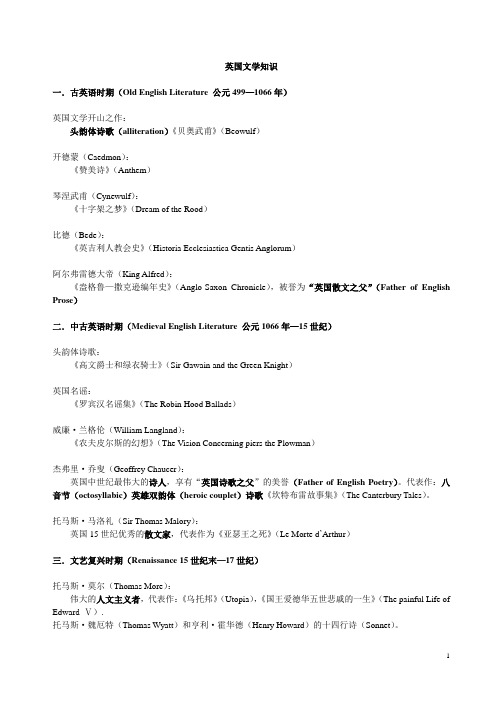
英国文学知识一.古英语时期(Old English Literature 公元499—1066年)英国文学开山之作:头韵体诗歌(alliteration)《贝奥武甫》(Beowulf)开德蒙(Caedmon):《赞美诗》(Anthem)琴涅武甫(Cynewulf):《十字架之梦》(Dream of the Rood)比德(Bede):《英吉利人教会史》(Historia Ecclesiastica Gentis Anglorum)阿尔弗雷德大帝(King Alfred):《盎格鲁—撒克逊编年史》(Anglo-Saxon Chronicle),被誉为“英国散文之父”(Father of English Prose)二.中古英语时期(Medieval English Literature 公元1066年—15世纪)头韵体诗歌:《高文爵士和绿衣骑士》(Sir Gawain and the Green Knight)英国名谣:《罗宾汉名谣集》(The Robin Hood Ballads)威廉·兰格伦(William Langland):《农夫皮尔斯的幻想》(The V ision Concerning piers the Plowman)杰弗里·乔叟(Geoffrey Chaucer):英国中世纪最伟大的诗人,享有“英国诗歌之父”的美誉(Father of English Poetry)。
代表作:八音节(octosyllabic)英雄双韵体(heroic couplet)诗歌《坎特布雷故事集》(The Canterbury Tales)。
托马斯·马洛礼(Sir Thomas Malory):英国15世纪优秀的散文家,代表作为《亚瑟王之死》(Le Morte d’Arthur)三.文艺复兴时期(Renaissance 15世纪末—17世纪)托马斯·莫尔(Thomas More):伟大的人文主义者,代表作:《乌托邦》(Utopia),《国王爱德华五世悲戚的一生》(The painful Life of Edwar d Ⅴ).托马斯·魏厄特(Thomas Wyatt)和亨利·霍华德(Henry Howard)的十四行诗(Sonnet)。
英美文学

英国文学一、中古英国文学The Old English Literature ( 449 to 1066 )Old English(古英语):盎格鲁撒克逊人的语言被叫作古英语,是英语语言和文学的基础。
Romance(中世纪的传奇故事):是中世纪流行的一种文体,通常是长篇的写作,有时可为诗篇(verse),也可以是散文(prose),一般描述的是英雄的生平和传奇。
A:The Growth of Arthurian legendsB:Sir Gawain and the Green Knight《高文爵士与绿衣骑士》:长篇中世纪传奇故事,讲述的是高文爵士接受绿衣骑士的挑战,最后获得来自骑士赠予的腰带,而被广泛流传。
C: Robin hoodD:John Wycliff(1320-1384)Pioneer “the Morning Star of the ReformationE:William Langland(威廉·兰格伦,1332-1400):与乔叟同时代The Vision of Piers Plowman《农夫皮尔斯之幻想》Geoffrey Chaucer(1340-1400):被称为the father of English poetry或者the father of English fiction,他的作品充满活力而敏捷。
The Canterbury Tales《坎特伯雷故事集》Excerpt from The Prologue of The Canterbury TalesIt is writing in heroic couplet, a pair of rhyming iambic pentameter linesheroic Couplet:two lines rhymed两行诗押同一韵iambic pentameter:五步抑扬格二、文艺复兴时期文学The English Renaissance LiteratureRenaissance(文艺复兴):人文主义是英国文艺复兴的核心,共分为三个阶段,Thomas More(托马斯·莫尔,1478-1535):Utopia《乌托邦》Thomas Wyatt(托马斯·怀亚特,1503-1542):16世纪上半叶最有趣的诗人,他首次将十四行诗(sonnet)引入英语文学中。
中古英国文学
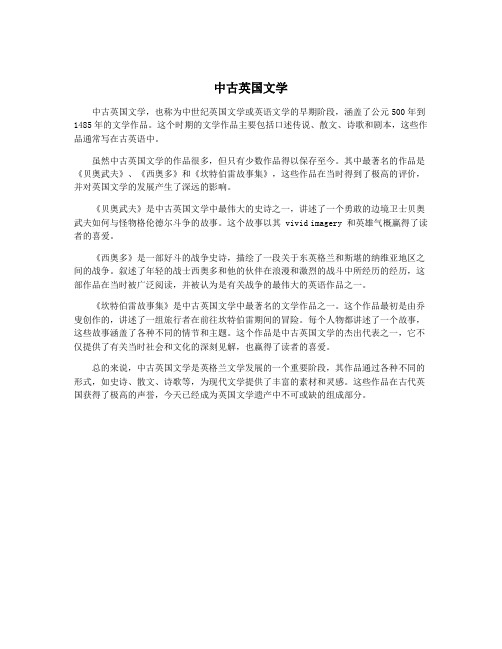
中古英国文学
中古英国文学,也称为中世纪英国文学或英语文学的早期阶段,涵盖了公元500年到1485年的文学作品。
这个时期的文学作品主要包括口述传说、散文、诗歌和剧本,这些作品通常写在古英语中。
虽然中古英国文学的作品很多,但只有少数作品得以保存至今。
其中最著名的作品是《贝奥武夫》、《西奥多》和《坎特伯雷故事集》,这些作品在当时得到了极高的评价,并对英国文学的发展产生了深远的影响。
《贝奥武夫》是中古英国文学中最伟大的史诗之一,讲述了一个勇敢的边境卫士贝奥武夫如何与怪物格伦德尔斗争的故事。
这个故事以其 vivid imagery 和英雄气概赢得了读者的喜爱。
《西奥多》是一部好斗的战争史诗,描绘了一段关于东英格兰和斯堪的纳维亚地区之间的战争。
叙述了年轻的战士西奥多和他的伙伴在浪漫和激烈的战斗中所经历的经历,这部作品在当时被广泛阅读,并被认为是有关战争的最伟大的英语作品之一。
《坎特伯雷故事集》是中古英国文学中最著名的文学作品之一。
这个作品最初是由乔叟创作的,讲述了一组旅行者在前往坎特伯雷期间的冒险。
每个人物都讲述了一个故事,这些故事涵盖了各种不同的情节和主题。
这个作品是中古英国文学的杰出代表之一,它不仅提供了有关当时社会和文化的深刻见解,也赢得了读者的喜爱。
总的来说,中古英国文学是英格兰文学发展的一个重要阶段,其作品通过各种不同的形式,如史诗、散文、诗歌等,为现代文学提供了丰富的素材和灵感。
这些作品在古代英国获得了极高的声誉,今天已经成为英国文学遗产中不可或缺的组成部分。
古英语和中古英语文学
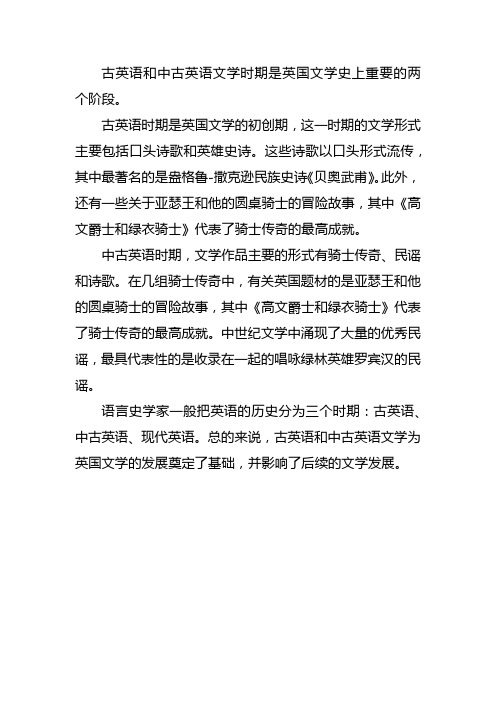
古英语和中古英语文学时期是英国文学史上重要的两个阶段。
古英语时期是英国文学的初创期,这一时期的文学形式主要包括口头诗歌和英雄史诗。
这些诗歌以口头形式流传,其中最著名的是盎格鲁-撒克逊民族史诗《贝奥武甫》。
此外,还有一些关于亚瑟王和他的圆桌骑士的冒险故事,其中《高文爵士和绿衣骑士》代表了骑士传奇的最高成就。
中古英语时期,文学作品主要的形式有骑士传奇、民谣和诗歌。
在几组骑士传奇中,有关英国题材的是亚瑟王和他的圆桌骑士的冒险故事,其中《高文爵士和绿衣骑士》代表了骑士传奇的最高成就。
中世纪文学中涌现了大量的优秀民谣,最具代表性的是收录在一起的唱咏绿林英雄罗宾汉的民谣。
语言史学家一般把英语的历史分为三个时期:古英语、中古英语、现代英语。
总的来说,古英语和中古英语文学为英国文学的发展奠定了基础,并影响了后续的文学发展。
- 1、下载文档前请自行甄别文档内容的完整性,平台不提供额外的编辑、内容补充、找答案等附加服务。
- 2、"仅部分预览"的文档,不可在线预览部分如存在完整性等问题,可反馈申请退款(可完整预览的文档不适用该条件!)。
- 3、如文档侵犯您的权益,请联系客服反馈,我们会尽快为您处理(人工客服工作时间:9:00-18:30)。
2.Wessex Literature
2.Wessex Literature
2.Wessex Literature
The second highlights happened during the reign of King Alfred.(871-899) (1)A number of Latin books of educative value
Christianized. • Churches were established and monks bacame the most learned in the country. • Heavens mythology was gradually replaced by Christian Religion.
Northumbrian School & Wessex Literature
1.Northumbrian School
1.Northumbrian School
• Its center was the monasteries and the abbeys in the kingdom of the northumbria. • Related with this schol was Ceadmon who turned the stories in the Bible into verse form. The title was Paraphrase. • Ceadmon could sing and became the first Anglo-Saxon poet.
Brief Introduction
• In the poem, Beowulf, a hero of the Geats, battles three antagonists: Grendel, who has been attacking the mead hall in Denmark called Heorot and its inhabitants; Grendel's mother; and, later in life after returning to Geatland (modern southern Sweden) and becoming a king, he fights an unnamed dragon. Beowulf is fatally wounded in the final battle, and after his death he is buried in a barrow in Geatland by his retainers.
1.Northumbrian School
• Another well-known figure related with the Northumbrian School was the Venerable Bede. • “father of the English history” • “The Ecclesiatial History of the English People”—covering the length of the early English from the invasion by Julius Caesar.
Anglo-Saxon Chronicle
Anglo-Saxon Poetry
• There are a long poetry Beowulf, a number of religious poems and historical poems, and some elegies.
Beowulf
4. About 450 A.D., waves of the Angles, Saxons, and Jutes invaded the British Isles.
• The Anglo-Saxons defeated the Celts, and became the new master of the British Isles and were the ancestors of the present English people.
3. From 55 B.C. to 407 A.D. the British were under the rule of Roman Empire, which had a high level of civilization.
• The first Roman general came to Britain was the famous Julius Caesar.
• The Roman ruled over Britain for three and half centuries. • They built temples, roads, walls, and military camps, but made little influences on the cultural life of the Celts. • Most of our knowledge of the Roman Britain comes from De Bello Galico, a book written by Caesar, and Germania by Publius Cornelius Tacitus (55-120 A.d.).
6. After Anglo-Saxons’ settlement in Britain, their tribal society gradually dis integrated and feudal society came into being.
7. In the later part of the 8th century, the Danes, or the Vikings, came to invade England. 8. In the second half of the 9th century, King Alfred of the Wessex led the Anglo-Saxon kings to defeat the invaders by uniting their forces.
5. About 500 A.D., King Authur, the founder of the kingdom of Wessex, acquired his fame while struggling against Cerdic.
• He gathered around him the bravest of his followers, who were known as the Knights of the Round Table and for 24 years he fought against the Anglos-Saxons invaders.
Thank you! --魏昃临
9. Norman Conquest: in 1066, the Nomans came from Nomandy in northern France attacked England under the leadship of the Duck of Normandy.
**10. In 579 Pope Gregory the Great sent St. Augustine to England to convert the Anglo-Saxons. • Within in a century, all England was
Pope Gregory the Great
St. Augustine
Northumbrian School & Wessex Literature
• There were 2 highlights in the development of the Anglo-Saxon literature.
• The poem contains 3183 lines and the story in it is based on partly historical and partly legendary materials, brought over by the Anglo-Saxon from their original homes.
Chapter One
The Anglo-Saxon Period (450-1066) --魏昃临
Historical Background
1. About B.C.the Celts migrated to the British Isles. 2. About 400 to 330 B.C. the Brythons, a branch of the Celts, came to British Isles and from them came the name Britain.
were translated into West Saxon dialects. (2)Alfred was responsible for the launching of the Anglo-Saxon Chronicle. (3)He created a style of Anglo-Saxon prose ehich was not obscure.
